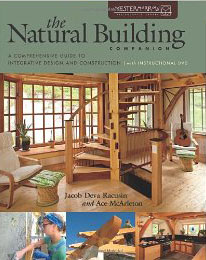
The Natural Building Companion
Reviewed by Kelly Hart
The Natural Building Companion: A Comprehensive Guide to Integrative Design and Construction, by Jacob Deva Racusin and Ace McArleton, published in 2012 by Chelsea Green Publishing is a book with a rare degree of detail on the topics covered. It is an extremely valuable resource for those interested in actually building with the materials that it covers, which are primarily wood, straw, earth and stone. The experience and focus of the authors is on appropriate techniques for the climate of the Northeastern United States. This book would make an excellent text book, and indeed the authors are associated with Yestermorrow, the design/build school in Vermont.
It begins with a thorough investigation of the context for natural building, especially in the Northeast; ecological factors, proper siting for buildings, the geology of mineral building materials, as well as local plant and animal products, are all covered with great detail.
The next section dives into the science and performance of building technologies, dealing first with structural issues related to straw bale and mass walls. Thermal performance strategies for natural building are investigated with a lot of corroborating data from actual testing the authors have done.
A whole chapter is devoted to issues related to moisture and how it affects buildings. How to keep excess moisture out of buildings, the importance of breathable walls, how to provide good drainage around buildings, and the effectiveness of rain screen design is explored. Mitigating the risk of fire and insect damage is also discussed.
How do you approach making proper design choices in the first place, taking into account the need for balancing cost, time and quality? Where are your priorities in this regard? They point out that non-standard construction often takes more time, and thus costs more, but the end product may be of higher quality.
One of the best chapters in my opinion is devoted to foundations for buildings, with some of the clearest illustrations I’ve seen for exactly how various types of foundations are actually made. These cover frost wall foundations using AAC blocks, insulated concrete forms, rubble trench, frost-protected shallow foundations, pole and pier, and rammed tires. A chapter on various framing methods for natural buildings focuses on post and beam, timber framing, pole framing, stud wall framing, and even steel framing.
Exploring natural insulative wall systems, such as straw bale, is really at the heart of this book. It goes into great detail on this subject, almost to the point of being a separate book within a book. Along with straw bale, both straw-clay and woodchip-clay are covered.
The use of earth and stone to construct natural mass wall structures comprises another chapter. This includes the use of adobe, wattle and daub, stone, rammed earth, rammed tire, and earthbag. There is a side bar in this chapter that describes cordwood, and I feel that their treatment of this well established natural building technique is unfortunately unduly negative.
There is an excellent section on natural plasters and paints and how to mix and apply them. This is one of the best presentations of a subject that is frequently skirted in books that I’ve seen. A range of appropriate roofs for natural buildings is covered, and so are flooring options. To finish the book, available choices for mechanical systems and utilities are explained.
Altogether, I feel that this book is well worth its hefty price ($60), given that it not only provides such a wealth of detail and analysis, but it is also packaged with a comprehensive DVD of instructional material that dovetails with the content. I give the book high marks

For Email contact go to About Us
Established in 2001, GreenHomeBuilding.com is primarily a labor of love. Kelly, and the GreenHomeBuilding team of experts, have answered thousands of questions for readers over the years, and we continue to publish up-to-date information about increasingly important sustainable architecture. If you feel moved to assist us in this work, your kind donation would be much appreciated; this can be easily done through our PayPal account:

VISIT OUR OTHER WEBSITES:
[Natural Building Blog] [Earthbag Building] [Dream Green Homes]
Disclaimer Of Liability And Warranty
I specifically disclaim any warranty, either expressed or implied, concerning the information on these pages. Neither I nor any of the advisor/consultants associated with this site will have liability for loss, damage, or injury, resulting from the use of any information found on this, or any other page at this site. Kelly Hart, Hartworks LLC.

